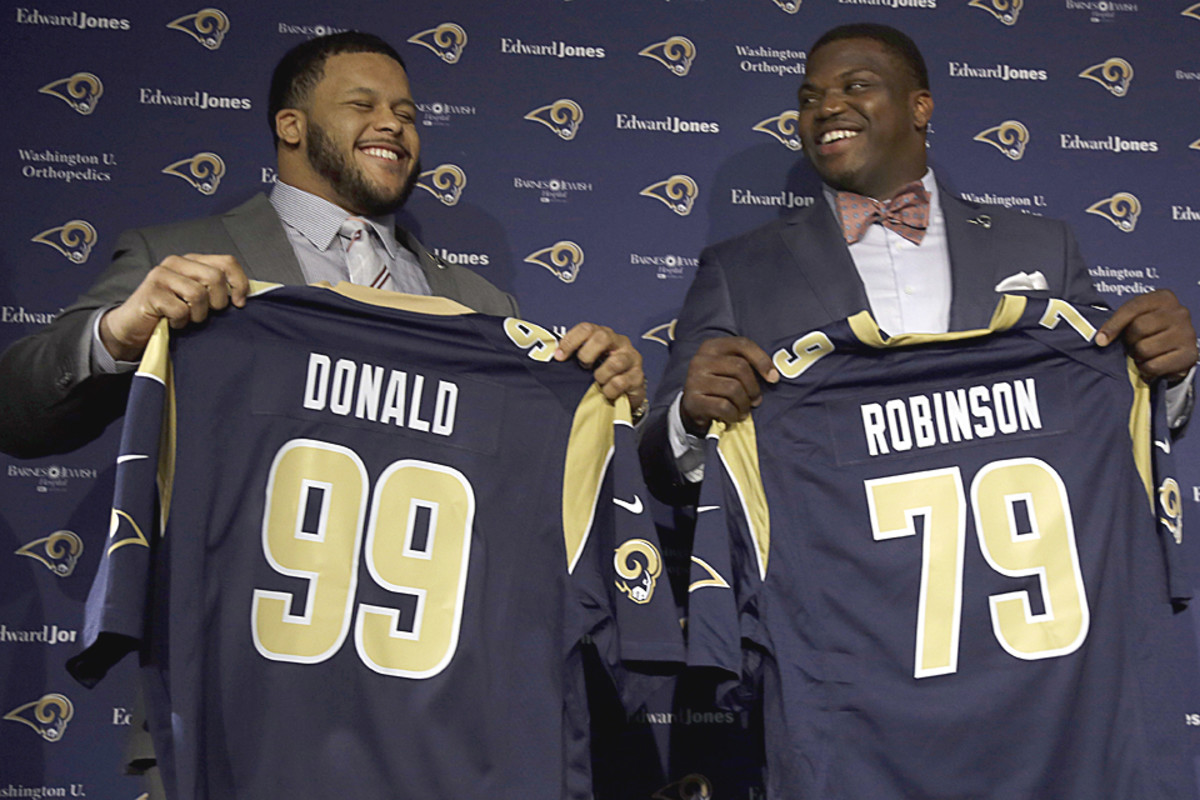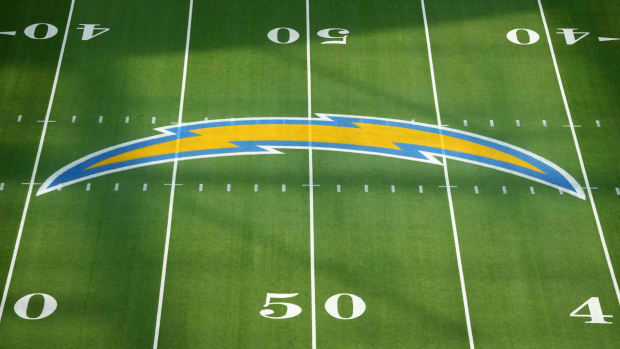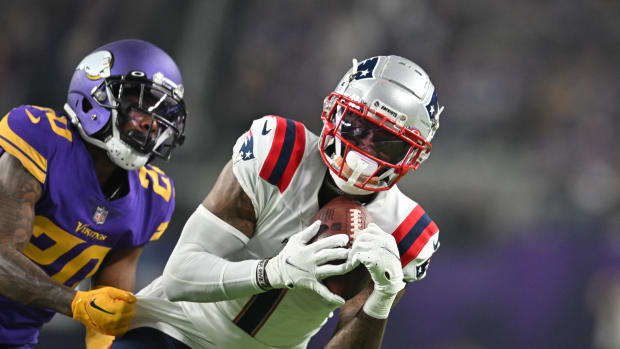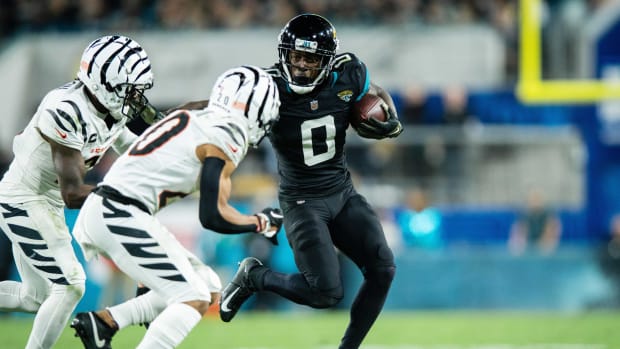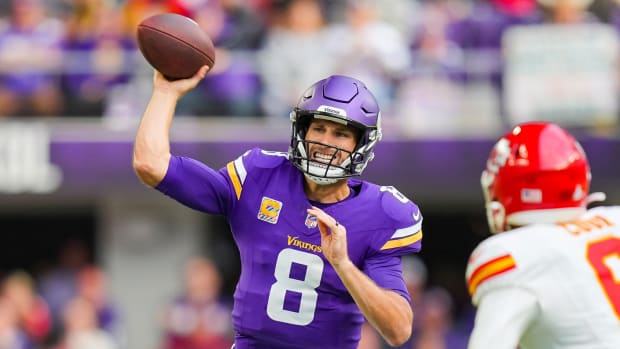What It All Means: NFC Draft Breakdowns
Arizona Cardinals
1.27 Deone Bucannon, S, Washington St.
2.20 Troy Niklas, TE, Notre Dame
3.20 Kareem Martin, DE, North Carolina
3.27 John Brown, WR, Pittsburg St.
4.20 Logan Thomas, QB, Virginia Tech
5.20 Ed Stinson, DL, Alabama
6.20 Walt Powell, WR, Murray St.
The Cardinals already had the best safety from last year’s draft in Tyrann Mathieu. They may have the best one from this year’s, too. Scouts love Deone Bucannon’s physicality, which should suit him well in the box as he prepares to replace cagey veteran Yeremiah Bell. Because Mathieu plays the slot in nickel and dime, Bucannon needs to be an adept half-field defender deep, as well.
Troy Niklas, the fifth Notre Dame tight end drafted in the top two rounds since 2006, should start immediately alongside Rob Housler and ahead of John Carlson, another one of those Golden Domers.
With a quality backup 3-4 end already on the roster in Frostee Rucker, Kareem Martin’s selection suggests Darnell Dockett could receive fewer snaps moving forward. Dockett is still a top-shelf defensive end, but he turns 33 at the end of this month and plays with an exhausting amount of ferocity.
John Brown may be a forgettable name, but the speedster may not be as the No. 3 receiver job—currently held by free agent pickup Ted Ginn—is ripe for the taking.
Atlanta Falcons
The Falcons tried to trade up for Jake Matthews. They couldn't, but their left tackle of the future fell into their lap anyway. (Wesley Hitt/Getty Images)
1.06 Jake Matthews, OT, Texas A&M
2.05 Ra'Shede Hageman, DE, Minnesota
3.04 Dezmen Southward, FS, Wisconsin
4.03 Devonta Freeman, RB, Florida State
4.39 Prince Shembo, LB, Notre Dame
5.07 Ricardo Allen, CB, Purdue
5.28 Marquis Spruill, OLB, Syracuse
7.38 Yawin Smallwood, ILB, Connecticut
7.40 Tyler Starr, OLB, South Dakota
Many (understandably) believed Atlanta needed a galvanizing pass-rusher. GM Thomas Dimitroff and head coach Mike Smith, however, believe that a pass rush can be manufactured with blitzes and pre-snap overloads. That’s why Jake Matthews was, according to our Peter King, the man Dimitroff coveted in his unsuccessful attempt to trade up to No. 3. Luckily for Atlanta, Matthews fell to No. 6. His bloodline seemingly guarantees success and allays what had become a crippling pass protection problem. Matthews is slated to begin at right tackle, but given his sound technique it would not be surprising to see him wedge out Sam Baker on the left side.
Atlanta didn’t neglect the defensive side of the ball, as the Falcons invested a second-rounder in Ra’Shede Hageman, who will bring athleticism as a five-technique end, lightening the workload of clogger Paul Soliai and Corey Peters, who is coming off an Achilles injury. Dezman Southward will try to fill the gaping hole at free safety after the release of the erratic Thomas DeCoud.
Carolina Panthers
1.28 Kelvin Benjamin, WR, Florida State
2.28 Kony Ealy, DE, Missouri
3.28 Trai Turner, OG, LSU
4.28 Tre Boston, FS, North Carolina
5.08 Bene Benwikere, CB, San Jose St.
6.28 Tyler Gaffney, RB, Stanford
Maybe Cam Newton doesn’t need to fine-tune his accuracy after all. Newton’s new top target, Kelvin Benjamin, has an 83-inch wingspan plus good leaping ability. It’s disconcerting that Benjamin was the only receiver taken by GM Dave Gettleman. One could make the argument that Carolina entered the draft needing three wideouts. It’s not like there weren’t quality choices available late; Gettleman must be higher than most on worn veteran pickups Jerricho Cotchery and Jason Avant.
Or maybe Gettleman just loved all the other players he selected. According to draft pundits like SI.com’s Chris Burke, Ealy was a major steal late in Round 2. Trai Turner should upgrade an interior line that was in dire straits last year; Nate Chandler, a defensive tackle in 2012, was switched to offense and was pressed into the starting lineup at right guard.
Gettleman landed a second Tre (different spelling) on his next pick, nabbing safety Tre Boston. It could be taken as a tacit admission that Carolina is not wild about offseason pickup Thomas DeCoud. Boston will compete with DeCoud, as well as Ryan Lester, for a starting job.
Chicago Bears
1.14 Kyle Fuller, CB, Virginia Tech
2.19 Ego Ferguson, DT, LSU
3.18 Will Sutton, DT, Arizona St.
4.17 Ka'Deem Carey, RB, Arizona
4.31 Brock Vereen, S, Minnesota
6.07 David Fales, QB, San Jose St.
6.15 Pat O'Donnell, P, Miami (Fla.)
7.31 Charles Leno Jr., OT, Boise St.
Ask a Bears fan how they feel about their team’s first-round selection and you’ll probably get an answer along the lines of “eh.” But most Bears fans at least understand the rationale behind the pick. Kyle Fuller may not be a dazzler, especially in a year when the defense had more dire needs up front, but the off-man/zone corner embodies the team’s patience and foresight. He’s the heir to Charles Tillman in the long-term. In the short-term, perhaps Fuller can beat out Kelvin Hayden (who is returning from a season-ending torn left hamstring) for nickel duties.
After Fuller, the need up front was addressed with Ego Ferguson and Will Sutton. Incredibly, depth could still be an issue at defensive tackle if veteran starters Jeremiah Ratliff and Stephen Paea can’t shake the injury bugs that hindered them in 2013.
Ka’Deem Carey was a solid addition; it’s wise to have someone help shoulder Matt Forte’s load. Brock Vereen (New England RB Shane’s brother) was selected because it must be a franchise bylaw that the Bears are to take a safety in the third or fourth round.
Dallas Cowboys
Jerry Jones is hoping Demarcus Lawrence can do some of the things DeMarcus Ware used to do in Big D. (Drew Nash/AP/The Times-News)
1.16 Zack Martin, OT, Notre Dame
2.02 Demarcus Lawrence, DE, Boise St.
4.19 Anthony Hitchens, OLB, Iowa
5.06 Devin Street, WR, Pittsburgh
7.16 Ben Gardner, DE, Stanford
7.23 Will Smith, OLB, Texas Tech
7.33 Ahmad Dixon, SS, Baylor
7.36 Ken Bishop, DT, Northern Illinois
7.39 Terrance Mitchell, CB, Oregon
It was irresponsible for anyone to hype the Manziel-to-Dallas pipe dream. It bolstered Thursday night ratings but totally misrepresented what Jerry Jones & Co. were thinking. According to The Dallas Morning News, the Cowboys were hoping to spend the 16th pick on defensive front seven forces Anthony Barr, Aaron Donald or Ryan Shazier. With all three off the board they settled for Zack Martin, who will start his career at guard but could eventually move to right tackle, kicking Doug Free inside and thus upgrading two positions along what could be a very good offensive line.
As their original first-round targets suggest, the Cowboys needed help on the other side of the ball after their defense allowed a league-worst 415.3 yards per game. That’s why Dallas traded up to get Demarcus Lawrence, who will almost certainly be the team’s top nickel pass-rusher this year. Though whether he can replace that other DeMarcus, future Hall of Famer Ware, seems unlikely.
The selection of Anthony Hitchens is an eye-opener; it could be the first step in the Cowboys’ eventual divorce from talented but inconsistent weakside linebacker Bruce Carter.
Detroit Lions
Eric Ebron gives the Lions one more matchup nightmare in the passing game. (Grant Halverson/Getty Images)
1.10 Eric Ebron, TE, North Carolina
2.08 Kyle Van Noy, OLB, BYU
3.12 Travis Swanson, C, Arkansas
4.33 Nevin Lawson, CB, Utah St.
4.36 Larry Webster, DE, Bloomsburg
5.18 Caraun Reid, DT, Princeton
6.13 TJ Jones, WR, Notre Dame
7.14 Nate Freese, K, Boston College
Obviously, Eric Ebron will enjoy the luxury of playing alongside a double-team magnet like Calvin Johnson. But Ebron will thrive due to more than just Megatron’s presence. Reggie Bush’s routes out of the backfield usually stress linebackers and drop-down safeties—the same defenders who normally provide help coverage on the tight end. Ebron can also detach from the formation and play the slot, an important facet of coordinator Joe Lombardi’s system.
Kyle Van Noy is the type of fluid mover the Lions have featured in their 4-3, zone-heavy defense. He’ll play the strong side. Should new defensive coordinator Teryl Austin change things up, Van Noy can also play the weakside in a 3-4. Travis Swanson was brought in to eventually supplant Dominic Raiola, who is coming off his best season in years but will turn 36 in December.
Green Bay Packers
1.21 Ha Ha Clinton-Dix, S, Alabama
2.21 Davante Adams, WR, Fresno St.
3.21 Khyri Thornton, DE, Southern Mississippi
3.34 Richard Rodgers, TE, California
4.21 Carl Bradford, OLB, Arizona St.
5.21 Corey Linsley, OC, Ohio State
5.36 Jared Abbrederis, WR, Wisconsin
6.21 Demetri Goodson, CB, Baylor
7.21 Jeff Janis, WR, Saginaw Valley
The Packers used several young safeties in recent years. Most of them were mid-round picks, and the results were middling. Ha Ha Clinton-Dix is a rangy centerfield type, which will allow Morgan Burnett to play with more of a downhill tilt. Clinton-Dix’s arrival also allows Green Bay to keep Micah Hyde as a slot corner, where he impressed last year.
Davante Adams can eventually fill the void created by James Jones’s departure, though he’ll likely start as the Packers’ No. 4 receiver as Jarrett Boykin is promoted to Jones’s old spot. The Khyri Thornton selection is the latest example of GM Ted Thompson’s draft day addiction to defensive lineman. The Packers already had four D-lineman taken in the top two rounds of recent drafts, plus intriguing 2013 fifth-rounder Josh Boyd and recently signed ex-Viking Letroy Guion. All this for a team that often lines up with just two defensive linemen in its base nickel package.
Richard Rodgers’ immediate future could depend on Jermichael Finley’s status. (There are rumors of Finley returning to the Pack once he gets a clean bill of health.) Corey Lindsey might compete for a starting job even as a fifth-round rookie; the only other options at the pivot are J.C. Tretter, who did not see the field last season as a fourth-round rookie, and practice squad veteran Garth Gerhart.
Minnesota Vikings
Teddy Bridgewater could hit the ground running as the Vikings' Week 1 starter. (John Sommers II/Getty Images)
1.09 Anthony Barr, OLB, UCLA
1.32 Teddy Bridgewater, QB, Louisville
3.08 Scott Crichton, DE, Oregon St.
3.32 Jerick McKinnon, RB, Georgia Southern
5.05 David Yankey, OG, Stanford
6.06 Antone Exum, S, Virginia Tech
6.08 Kendall James, CB, Maine
7.05 Shamar Stephen, DT, Connecticut
7.08 Brandon Watts, LB, Georgia Tech
7.10 Jabari Price, CB, North Carolina
With edge rushers Everson Griffen and Brian Robison both locked in long-term, the Vikings can afford to let Anthony Barr develop in a pass-rush specialist role. Barr will probably need the extra time; he’s only played defense for two years. New head coach Mike Zimmer could use his rookie wunderathlete as a standup joker in his zone-blitz packages. Though Griffen's ability to fill that role, plus the fact that defensive end Scott Crichton was chosen in the third round, suggests the Vikings could use Barr in a traditional linebacker role.
Teddy Bridgewater might have a chance to learn on the field as a rookie. Though if everything breaks right the Vikings could be Wild Card contenders with veteran Matt Cassel in 2014.
Jerick McKinnon isn’t going to replace Toby Gerhart; the converted QB is too raw as a receiver and pass protector to take many snaps behind Adrian Peterson. David Yankey could be a good value, as there’s no reason for the Vikings to lock veterans Charlie Johnson or Brandon Fusco into starting roles.
New Orleans Saints
1.20 Brandin Cooks, WR, Oregon St.
2.26 Stanley Jean-Baptiste, CB, Nebraska
4.26 Khairi Fortt, ILB, California
5.27 Vinnie Sunseri, S, Alabama
5.29 Ronald Powell, OLB, Florida
6.26 Tavon Rooks, OT, Kansas St.
Brandin Cooks could not have fallen into a better situation. The system Sean Payton and Drew Brees have built will take advantage of his quickness in and out of breaks, downfield ball tracking and creativity after the catch. Cooks can replace some of what the Saints lost with the departures of Lance Moore and Darren Sproles. He’s small, but that’s no longer a major issue in today’s finesse NFL.
Stanley Jean-Baptiste is a physical, lanky press corner in the Seattle mold. A converted wide receiver, he’ll draw comparisons to Richard Sherman. Sherman rode the bench for the first half of his rookie season, and Jean-Baptiste may do the same. But with Patrick Robinson coming off a serious knee injury (and not a lock to make the team), Rob Ryan might need the rookie to play right away. Then again, Ryan often prefers to play three safeties in his dime package, so maybe it’s Vinnie Sunseri who will see more action. Close to fully recovered from a torn ACL suffered last October, Sunseri will push Rafael Bush for that third safety role.
New York Giants
1.12 Odell Beckham Jr., WR, LSU
2.11 Weston Richburg, OC, Colorado St.
3.10 Jay Bromley, DT, Syracuse
4.13 Andre Williams, RB, Boston College
5.12 Nat Berhe, S, San Diego St.
5.34 Devon Kennard, LB, USC
6.11 Bennett Jackson, CB, Notre Dame
Odell Beckham Jr. has been championed for precise route running, a must when playing with a gutsy, squeeze-it-into-the-window passer like Eli Manning; he likes to find receivers either really early or really late out of their breaks. Perhaps Manning’s style will change under first-year coordinator Ben McAdoo, who comes over from Green Bay. Regardless, the Giants need Beckham ready to go right away; the new system often uses three-receiver personnel.
Weston Richburg also must be ready on Day One. New York’s only other experienced centers are J.D. Walton, the ex-Bronco who missed most of the past two seasons with injuries, and journeyman Dallas Reynolds. GM Jerry Reese and Tom Coughlin must have really liked Andre Williams; this club did not seem to have room for another running back. Now it’s a matter of which backup will be jettisoned to make room for Williams: Peyton Hillis or Da’Rel Scott. David Wilson could be on the chopping block as well as he works his way back from neck surgery, but that seems like a long shot considering how dynamic he’s looked at times when healthy.
On defense, Jay Bromley should enter the rotation immediately. New York’s front four is nowhere near as potent or deep as it was a few years ago.
Philadelphia Eagles
Speedy slot receiver Josh Huff joins the Eagles as part of Chip Kelly's Oregon family reunion. (Jonathan Ferrey/Getty Images)
1.26 Marcus Smith, DE/OLB, Louisville
2.10 Jordan Matthews, WR, Vanderbilt
3.22 Josh Huff, WR, Oregon
4.01 Jaylen Watkins, DB, Florida
5.01 Taylor Hart, DE, Oregon
5.22 Ed Reynolds, S, Stanford
7.09 Beau Allen, DT, Wisconsin
It’s hard to see where Marcus Smith fits up front. Yes, soon-to-be 32-year-old Trent Cole might play fewer snaps going forward, but that’s where former first-rounder Brandon Graham comes in. And, though he’s more of a down lineman, 2012 second-rounder Vinny Curry has the explosive first step to be a part-time standup rusher. Smith’s role this fall could be to back up Connor Barwin, which means the Eagles would be getting less than 10 meaningful snaps per game from their first-rounder.
The Eagles at least traded down before taking Smith. Aided by the acquisition of additional picks, they added a pair of wide receivers: Jordan Matthews, a 6-3, 212-pounder who will likely fill the Jason Avant role, and Josh Huff, a mighty mite slot receiver who played for Kelly at Oregon.
St. Louis Rams
1.02 Greg Robinson, OT, Auburn
1.13 Aaron Donald, DT, Pittsburgh
2.09 Lamarcus Joyner, CB, Florida State
3.11 Tre Mason, RB, Auburn
4.10 Maurice Alexander, S, Utah State
6.12 E.J. Gaines, CB, Missouri
6.38 Garrett Gilbert, QB, SMU
7.11 Mitchell Van Dyk, OT, Portland St.
7.26 Christian Bryant, S, Ohio State
7.34 Michael Sam, DE, Missouri
7.35 Demetrius Rhaney, OL, Tennessee St.
Greg Robinson is a raw talent who needs time to develop. He’ll initially do so at left guard, and many believe he’ll capture Jake Long’s left tackle job soon after. But Long, if healthy, is not a player you can squeeze out. Recall that Andre Smith entered the league as an enormous raw talent a few years ago and wound up finding a permanent home as Cincinnati’s right tackle. Robinson could do the same thing.
But right now Robinson is a guard, which likely means the Rams are staying committed to the between-the-tackles running game that kept their injury-marred offense afloat last year. Tre Mason can add some quickness to that cause, providing a nice complement to Zac Stacy. The Mason pick was also a tacit admission that Isaiah Pead, a second-round pick in GM Les Snead and Jeff Fisher’s first draft in St. Louis, is a bust.
Aaron Donald represents a classic case of the rich getting richer, as he joins what was arguably already the best front four in football. On a related note, getting drafted so late by St. Louis was just about the worst thing that could have happened to Michael Sam. There simply isn’t room for him unless Fisher is willing to carry five defensive ends. If Sam had gone undrafted, he could have chosen a team with less depth.
Lastly, Lamarcus Joyner and Mo Alexander will both have a chance to play right away given the paucity of talent in St. Louis’s secondary.
San Francisco 49ers
Carlos Hyde looks like the Niners' feature back of the future. (David Dermer/Diamond Images/Getty Images)
1.30 Jimmie Ward, DB, Northern Illinois
2.25 Carlos Hyde, RB, Ohio State
3.06 Marcus Martin, OC, USC
3.13 Chris Borland, ILB, Wisconsin
3.36 Brandon Thomas, OG, Clemson
4.06 Bruce Ellington, WR, South Carolina
4.29 Dontae Johnson, CB, N.C. State
5.10 Aaron Lynch, DE/OLB, South Florida
5.30 Keith Reaser, DB, Florida Atlantic
6.04 Kenneth Acker, CB, SMU
7.28 Kaleb Ramsey, DE/LB, Boston College
7.30 Trey Millard, FB, Oklahoma
A team that’s reached the NFL’s final four each of the past two years made seven of the first 129 selections in this year’s draft. Plus, the Niners acquired a sharp-skilled veteran, Stevie Johnson, for a mere fourth-round pick, instantly quelling concerns about depth at wide receiver. Outstanding job by GM Trent Baalke.
Jimmie Ward will be the No. 3 safety behind Eric Reid, a 2013 first-rounder who was scintillating as a rookie, and free agent addition Antoine Bethea. Reid isn't going anywhere, and while Bethea seemed to be in Indianapolis forever he doesn’t turn 30 until July, so the investment of a first-rounder in Ward could indicate that the Niners will move to a more-modern three-safety, three-corner dime package. That would mean either Patrick Willis or, more likely, the injured NaVorro Bowman, coming off the field in that package. Are the Niners skeptical of Bowman’s ability to come back from his gruesome leg injury? Not only do they now have dime personnel, but they also spent a third-round pick on inside linebacker Chris Borland.
Naturally, most of Baalke’s other picks are luxury items or long-term investments. Carlos Hyde can, hopefully, be the new Frank Gore whenever the actual Frank Gore runs out of gas. Marcus Martin can challenge for a starting spot right away. Once healthy, Brandon Thomas provides quality insurance across the line. Bruce Ellington adds depth to a now-rich receiving corps, while Dontae Johnson deepens a revamped (but still shaky) group of cornerbacks.
Seattle Seahawks
2.13 Paul Richardson, WR, Colorado
2.32 Justin Britt, OT, Missouri
4.08 Cassius Marsh, DE, UCLA
4.23 Kevin Norwood, WR, Alabama
4.32 Kevin Pierre-Louis, OLB, Boston College
5.32 Jimmy Staten, DT, Middle Tennessee St.
6.23 Garrett Scott, OT, Marshall
6.32 Eric Pinkins, CB, San Diego St.
7.12 Kiero Small, FB, Arkansas
GM John Schneider and Pete Carroll seemed to agree with their fans: Seattle’s biggest needs were at wide receiver and offensive line. Paul Richardson is similar to what the ‘Hawks have in Percy Harvin, a quick, fluid long-strider with a slight frame and durability concerns. Another wideout, Kevin Norwood, was added two rounds after the trade-down pick that brought Richardson. This suggests Schneider and Carroll are priming for a hard negotiation with Doug Baldwin, a restricted free agent who is looking for a new contract.
It seems only a matter of time until Justin Britt beats out last year’s seventh-rounder, Michael Bowie, for the departed Breno Giacomini’s old right tackle job. As for Cassius Marsh, Kevin Pierre-Louis and Jimmy Staten… we’ve seen Seattle uncover defensive gems in the middle rounds before.
Tampa Bay Buccaneers
1.07 Mike Evans, WR, Texas A&M
2.06 Austin Seferian-Jenkins, TE, Washington
3.05 Charles Sims, RB, West Virginia
5.03 Kadeem Edwards, OG, Tennessee St.
5.09 Kevin Pamphile, OT, Purdue
6.09 Robert Herron, WR, Wyoming
Apparently one Vincent Jackson wasn’t enough for Lovie Smith and new GM Jason Lichth. Now they have a second in Mike Evans. Austin Seferian-Jenkins also gives them a second tight end, which they’ll probably feature regularly in a base 12 package (one back, two tight ends). Tim Wright, undrafted a year ago, is set to break out as a premiere pass catcher. Seferian-Jenkins is cut from a more traditional cloth, a presence as a receiver and an in-line blocker.
THE MMQB ON THE u201914 DRAFT
Andy Benoit's breakdown of AFC teams' drafts.
FULL STORY
Peter King’s Monday Morning Quarterback look back at the draft. FULL STORY
Robert Klemko on Michael Sam’s giant leap.
FULL STORY
Ten later-round picks who could have a big impact.
FULL STORY
Richard Deitsch on how ESPN almost missed the Michael Sam moment. FULL STORY
Josh Gordon’s potential suspension casts a pall on Manziel Mania in Cleveland. FULL STORY
Jenny Vrentas on first round’s wild ride. FULL STORY
Greg Bedard’s first-round breakdown. FULL STORY
It’s hard to understand why Licht and Smith did not use their third-round selection on another wideout. They have nothing behind Jackson and Evans, while the guy they did take, Charles Sims, is joining a backfield that already boasts a featured weapon (Doug Martin), and two serviceable back-ups (Bobby Rainey and Mike James). Martin and James are both coming back from serious injuries, so perhaps Sims is just a pricey insurance policy.
Washington
2.15 Trent Murphy, OLB, Stanford
3.02 Morgan Moses, OT, Virginia
3.14 Spencer Long, OG, Nebraska
4.02 Bashaud Breeland, CB, Clemson
5.02 Ryan Grant, WR, Tulane
6.10 Lache Seastrunk, RB, Baylor
7.02 Ted Bolser, TE, Indiana
7.13 Zach Hocker, K, Arkansas
Washington gave up the second overall pick as part of the RG3 trade—a deal that’s looking more and more like a lopsided victory for the Rams. They spent their second-rounder on the one position where they’re well-stocked: outside linebacker. It seems unlikely that Brian Orakpo, who is working under a one-year franchise tag, won’t be re-signed long-term. So unless GM Bruce Allen doesn’t believe Ryan Kerrigan will be worth his price tag in 2016, there is not an obvious spot for Trent Murphy to fill.
There are obvious spots for Morgan Moses and Spencer Long: Moses at right tackle, where he’ll bring more athleticism than veteran scrapper Tyler Polumbus and Long at guard, where a vacancy should open up as either Chris Chester or, more likely, Kory Lichtensteiger, slides to center in place of Will Montgomery.
































